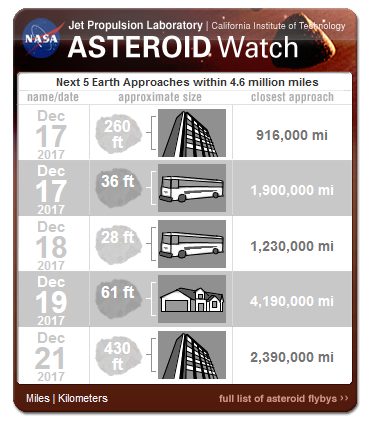Space Weather Daily Update for 16 December, 2017
Filament Erupts, Solar Activity Rising
Well, after not doing much at all, the Sun is finally showing some activity. A plasma filament lifted up snapped off. A Coronal Mass Ejection (CME) was recorded. When it does hit the Earth in the next couple of days, it should be minor. The Solar Wind is very low and stable and the Planetary K-index is showing this with very low green levels. We should expect an uptick tonight. If not, then we should get more of this...
Earthquakes
- 6.5 magnitude earthquake near, West Java, Indonesia
- 5.4 magnitude earthquake near Fiji
- 5.3 magnitude earthquake on the Central Mid-Atlantic Ridge
- 5.0 magnitude earthquake on the Pacific-Antarctic Ridge
And there were plenty more.
And on the volcano side
Space Objects
- Yesterday I mentioned how there were multiple Near Earth Objects(NEOs) stacking up for the 15th of December, well the 21st is getting a bunch itself. I guess the empty database will fill up as the month comes to a close.
Other News
Something pretty
- Crescent nebula
with something pretty powerful - Three missing, thousands flee as storm heads for Philippines
~ Ben Davidson (Suspicious0bservers ) at SuspiciousObservers.org
I am not affiliated with Ben Davidson or his work. I am a subscriber to SuspiciousObservers YouTube channel.
- Space Weather News
- Quake Watch
- Earth Changes - mobile app
- STARWATER
Space Weather


Source: http://www.swpc.noaa.gov/products/planetary-k-index
Asteroid Watch

Average distance between Earth and the moon is about 239,000 miles (385,000 kilometers).
Source: https://www.jpl.nasa.gov/asteroidwatch/
| Object | Flyby Date | AU distance | Approximate Size |
|---|---|---|---|
| (2017 VT14) | 2017-Dec-17 | 0.00985 | 63 m - 140 m |
| (2017 XT60) | 2017-Dec-17 | 0.02040 | 8.6 m - 19 m |
| (2017 XW60) | 2017-Dec-18 | 0.01327 | 6.6 m - 15 m |
| (2011 YD29) | 2017-Dec-19 | 0.04513 | 15 m - 33 m |
| (2017 WX12) | 2017-Dec-21 | 0.02571 | 100 m - 230 m |
Close Approach Database
Source: https://cneos.jpl.nasa.gov/ca/
Let the positive energy sing!
More Power to the Minnows!!




huh...never heard of cold lava...so I looked it up
also know as lahar
.
A lahar of sufficient size and intensity can erase virtually any structure in its path, and is capable of carving its own pathway, making the prediction of its course difficult. Conversely, a lahar quickly loses force when it leaves the channel of its flow: even frail huts may remain standing, while at the same time being buried to the roof line in mud. A lahar's viscosity decreases with time, and can be further thinned by rain, but it nevertheless solidifies quickly when coming to a stop.
.
Lahars vary in size and speed. Small lahars less than a few metres wide and several centimetres deep may flow a few metres per second. Large lahars hundreds of metres wide and tens of metres deep can flow several tens of metres per second (22 mph or more): much too fast for people to outrun.[3] With the potential to flow at speeds up to 100 kilometres per hour (60 mph), and flow distances of more than 300 kilometres (190 mi), a lahar can cause catastrophic destruction in its path.[5]
My guess, if I didn't look it up.
thanks reporting @deanlogic